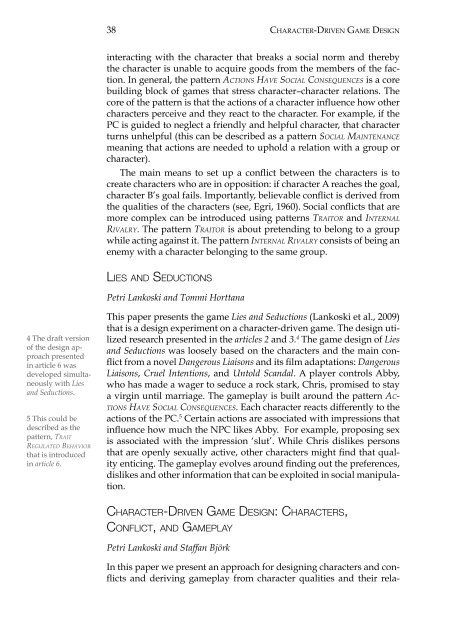Character Driven Game Design
Character Driven Game Design
Character Driven Game Design
You also want an ePaper? Increase the reach of your titles
YUMPU automatically turns print PDFs into web optimized ePapers that Google loves.
38<br />
<strong>Character</strong>-<strong>Driven</strong> <strong>Game</strong> <strong>Design</strong><br />
interacting with the character that breaks a social norm and thereby<br />
the character is unable to acquire goods from the members of the faction.<br />
In general, the pattern Actions Have Social Consequences is a core<br />
building block of games that stress character–character relations. The<br />
core of the pattern is that the actions of a character influence how other<br />
characters perceive and they react to the character. For example, if the<br />
PC is guided to neglect a friendly and helpful character, that character<br />
turns unhelpful (this can be described as a pattern Social Maintenance<br />
meaning that actions are needed to uphold a relation with a group or<br />
character).<br />
The main means to set up a conflict between the characters is to<br />
create characters who are in opposition: if character A reaches the goal,<br />
character B’s goal fails. Importantly, believable conflict is derived from<br />
the qualities of the characters (see, Egri, 1960). Social conflicts that are<br />
more complex can be introduced using patterns Traitor and Internal<br />
Rivalry. The pattern Traitor is about pretending to belong to a group<br />
while acting against it. The pattern Internal Rivalry consists of being an<br />
enemy with a character belonging to the same group.<br />
Lies and Seductions<br />
Petri Lankoski and Tommi Horttana<br />
4 The draft version<br />
of the design approach<br />
presented<br />
in article 6 was<br />
developed simultaneously<br />
with Lies<br />
and Seductions.<br />
5 This could be<br />
described as the<br />
pattern, Trait<br />
Regulated Behavior<br />
that is introduced<br />
in article 6.<br />
This paper presents the game Lies and Seductions (Lankoski et al., 2009)<br />
that is a design experiment on a character-driven game. The design utilized<br />
research presented in the articles 2 and 3. 4 The game design of Lies<br />
and Seductions was loosely based on the characters and the main conflict<br />
from a novel Dangerous Liaisons and its film adaptations: Dangerous<br />
Liaisons, Cruel Intentions, and Untold Scandal. A player controls Abby,<br />
who has made a wager to seduce a rock stark, Chris, promised to stay<br />
a virgin until marriage. The gameplay is built around the pattern Actions<br />
Have Social Consequences. Each character reacts differently to the<br />
actions of the PC. 5 Certain actions are associated with impressions that<br />
influence how much the NPC likes Abby. For example, proposing sex<br />
is associated with the impression ‘slut’. While Chris dislikes persons<br />
that are openly sexually active, other characters might find that quality<br />
enticing. The gameplay evolves around finding out the preferences,<br />
dislikes and other information that can be exploited in social manipulation.<br />
<strong>Character</strong>-<strong>Driven</strong> <strong>Game</strong> <strong>Design</strong>: <strong>Character</strong>s,<br />
Conflict, and <strong>Game</strong>play<br />
Petri Lankoski and Staffan Björk<br />
In this paper we present an approach for designing characters and conflicts<br />
and deriving gameplay from character qualities and their rela-
















